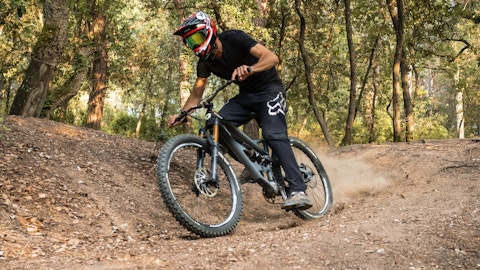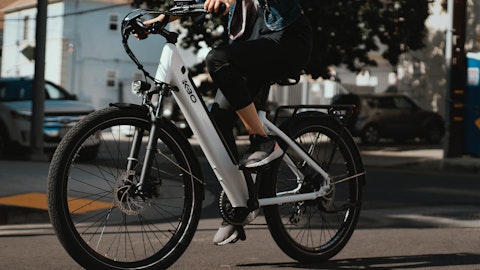Michael Dennison: Yes, Mike, we look at Shimano pretty closely, so we understand those same comments that they’re calling out. Again, there are in a different space than we are. We’re very niche, we’re very premium high-end. And I think when you look at the overall bike market in general, their statements are probably pretty accurate. When it comes to our business, I think it can be different. And so I think you’re off only by a couple of quarters or a quarter or two, which might be a reflection of just where we sit in the market versus where they do. I mean, they’re in the high end as well, but they’re in the entire line of bikes, not just the high end. So I think that’s the difference. And again, I don’t — Q2 is not going to be — we’re not looking to knock it out of the park in Q2, but we’re looking to be predictable and to go into a quarter feeling comfortable that we’re going to hit the number that we projected and we’re feeling good about that.
And that’s the start to the turnaround in my mind.
Michael Swartz: Okay, great. Thanks for the color there. And then second question is something I picked up in the press release just as it pertains to the prepaid. I think you made a comment about older model inventory or prepaids being one of the challenges right now. But is there any commentary you can add to that, or how to think about the percentage of your prepaid, that’s older model chassis versus new model chassis? I’m just wondering if that has any impact and potential risk to margins in the back half of the year.
Michael Dennison: Yes. Any type of prepaid balance right now would be associated with newer models coming onboard. So no real risk there. I think we mentioned the prepaid status just because that is an increase in our working capital and a hit to free cash flow for us. But we talk about that because this is the season when we actually have those prepaids billed. That makes sense?
Michael Swartz: Yeah. Thanks.
Michael Dennison: Mike, I think anything to think about there, too, is in Q1 we had to incentivize. We worked with our dealers to make sure inventory that was aging is moving across their lot, getting out of their lot. This is kind of a constant thing that we think about as we want to get into the new vehicle years and model year changes. So some of that pressure in Q1 was a function of us helping incentivize those dealers to move those vehicles. I think that’s really just around model year changing which happened Q1, Q2 this year, and we’re kind of through it.
Michael Swartz: Got you. Thanks, Mike.
Operator: Thank you. We’ll pick our final question today from Scott Stember of ROTH MKM.
Scott Stember: Good evening. Thanks for taking my questions.
Michael Dennison: Hey Scott.
Scott Stember: Question about the launch for the ’25 bike products. You did say that it should be three times more than, I guess, than what you’ve done in recent years. Given what’s still in the pipeline in the bike market and knowing dealers, I guess they’re going to be very cautious, I guess, with floor plan and interest rates about how much inventory they bring in. What are you looking at as far as, like, the size of this actual launch, despite the fact, or taking into account that you’re talking about three times? Are we looking at something that’s bigger than what you’ve done pre-pandemic or something a little bit more scaled back and modest?
Michael Dennison: Scott, I think you’re referring to volume curve.
Scott Stember: Yeah, full volumes.
Michael Dennison: Yeah, so I think it’s a good question. So on the volume, we’re still being pretty conservative in what we think these launches will deliver. And that shows up in our guide for the year, just based on the nature of the environment that you kind of described. I would tell you what we’re seeing in our conversations with dealers and distributors is if it’s new product, if it’s interesting and different, you’re not having to discount it and customers want it. If you’re really just retrading the same stuff that was on the shelf last year and the year before, you’re heavily discounting when people are walking past it because they just — they’ve already got it in the garage. They just don’t need it. But if it’s something new and different, they want it.
And that’s what’s so exciting. We’ve got a couple of launches that have already been pretty productive for us and compelling relative to demand on those products. So I think in our space right now, on bike new and different is everything. If you can’t come up with something new and exciting, you’re going to have a challenge. So that’s what makes us so excited about the 3x product launches. But again, I think on the volume for product launch, we’ll stay pretty conservative on what we think they’ll actually do until we see the results.
Scott Stember: Got it. And then just the last question about the upfitting or I guess the Fox factory branded upfitting in trucks and side by side, maybe just give us a little more context of how that will fit in to the individual platforms and what your expectations are for contribution if you can give that.
Michael Dennison: Yeah, that’s a new stage for us. So in side by side upfitting, we’re really talking about creating a class of vehicles in either the race content, or in the luxury UTV space that are well above what can we get purchased from a factory kind of production vehicle on the dealer floor. That’s been exciting for us because we’re reaching out to customers directly and through dealerships to sell those vehicles. And we think that’s kind of a different model. Same thing with a Fox Factory Truck. We actually have a concierge service now where you can contact us directly to put a deposit down on that truck. Now, ultimately transact that truck through a dealer near that individual or somewhere in the country. But we’re getting direct connection to the customer that’s purchasing the truck in that environment, and that’s a new thing for us.
So that’s pretty exciting. We think, as we expand those vehicles in both automotive and in side by side that that just continues to grow and expand and create kind of a new channel for us in how we market our high end vehicles. So pretty positive stuff for us.
Scott Stember: And then on the truck side, this is the last question. Are you worried about any potential cannibalization or will this be so far off the food chain that there’ll be no overlap?
Michael Dennison: Pretty far up the food chain. I had a lot of conversations when we launched the Fox Factory Truck with OEMs. It actually brought demand to us. Other OEMs came to us and said, hey, that’s pretty cool. We would like to actually talk about doing something like that with you. So it actually opens some doors, interestingly enough. And it’s so high up in kind of that pinnacle or that pyramid of vehicles that it doesn’t — it’s not in the same business as our Shelby business or anything else. It’s different than that and exciting for I think the entire market.
Scott Stember: Got it. That’s all I have. Thank you.
Michael Dennison: Thanks, Scott.
Operator: Thank you. And at this time, Mr. Dennison, I’d like to turn things back to you, sir, for any closing comments.
Michael Dennison: Thanks, Bob. I want to thank everyone for taking the time to join us tonight. And we will keep you guys updated as we progress through the quarter and look forward to talking to you soon. Have a good evening.
Operator: Thank you again, Mr. Dennison. Again, ladies and gentlemen, that does conclude today’s Fox Factory Holding Corporation’s first quarter fiscal 2024 earnings call. Again thanks so much for joining us. We wish you all a great evening. Goodbye.
Follow Fox Factory Holding Corp (NASDAQ:FOXF)
Follow Fox Factory Holding Corp (NASDAQ:FOXF)
Receive real-time insider trading and news alerts


